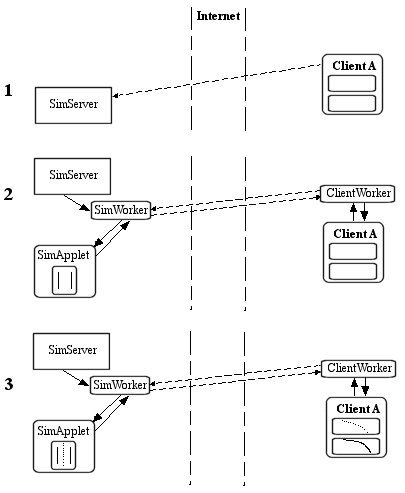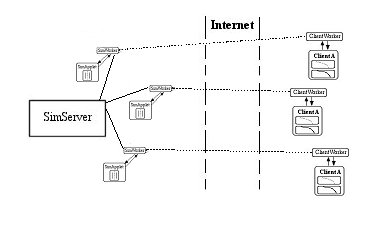
| Home : Course Map : Chapter 15 : |
|
Client/Server with a Physics Simulation
|
| JavaTech |
| Course Map |
| Chapter 15 |
|
Client/ServerDesign |
| About
JavaTech Codes List Exercises Feedback References Resources Tips Topic Index Course Guide What's New |
|
For another example of a client/server for a technical application, we will create a socket based system that sends data from a physics simulation server to clients rather than just dummy random value data. We will use classes from our gravitational acceleration experiment simulation, discussed in Chapter 9: Physics, to build out simulator. Such a system could be useful where you want to provide a central location for a simulation. This could be useful in a situation where the simulation is especially large and needs resources available on a particularly powerful machine or is being frequently modified and updated. Clients could log into the server, which would spin off a simulator dedicated to that particular client. If the simulation server existed on a multiprocessor system, then each simulator might get its own processor. The Client/Server Procedure The figures below illustrate the basic procedure and components involved in the system:
Another approach to the design of the system would combine the SimWorker with the simulation class (SimApplet) and combine the SimClientWorker with the SimClient class. This would reduce the communication lines that must occur among all of these actors. However, separating them provides greater modularity and one could either use the worker classes, or subclasses of them, with other types of simulators and clients. The Simulator For our simulator we use classes developed for the gravitational acceleration experiment demonstration program in Chapter 9: Physics. Here we split the program and use the experiment simulation classes for the server side and the analysis code for the client side. The design follows the aim that the server produces the data and the client analyzes the data. The modularity provided by the object oriented design helps with adapting the classes here, though in some cases new classes had to be developed for this case. More Info The client/server simulation is described further on these pages:
Last update: Dec.11, 2004 |

